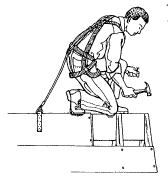FALLS: The Leading Killer on Construction Sites
Summary Statement
A handout with illustrations for residential workers debunking myths about the risks of falling and issues with using fall protection. Part of a collection. Click on the 'collection' button to access the other items.

Myths and Facts about Falls in Residential Construction
Myth I: Residential contractors don't get injured as badly as commercial construction workers.
FACT: One third of all construction workers who have fallen to their death in Massachusetts worked in residential construction.
A 30 year old roofer was rolling tar paper on a new pitch roof of a 2 story Cape when he backed off the edge. He fell 24 feet to his death, and left behind a wife and children.
A 68 year old painter died after falling 10 feet from a small front porch of a 2 story home. The painter fell when he climbed down a step ladder and leaned into a rotted porch railing. He had painted homes for over 40 years.
Myth 2: You have to fall a long distance to kill yourself.
FACT: Half the construction workers who died in a fall fell from a height of 21 feet or less. If you hit your head hard enough, you can die at any height. Even if you survive a fall, you may be laid up for some time with a disability.
Myth 3: Experienced workers don't fall.
FACT: The average age of construction workers who have fallen to their death was 47 - people with many years of experience.
"It just happens so fast. It's when you think you're safe that you need to be more careful." - Gene, Homebuilder
Myth 4: Working safely is costly.
 FACT: Much equipment is inexpensive, such as ladder stabilizers, guardrail holders, and fall protection kits. Other items such as scaffolds are more costly. Invest in this equipment, just as you would a quality tool. Injury is much more expensive in the end.
FACT: Much equipment is inexpensive, such as ladder stabilizers, guardrail holders, and fall protection kits. Other items such as scaffolds are more costly. Invest in this equipment, just as you would a quality tool. Injury is much more expensive in the end.
"I fell three stories and was out of work for 8 weeks. I was subcontracting and didn't have comp. This was a long time ago, but I probably lost around $5,000. A harness would have cost me $50 back then." ~ Dan, General Contractor
Myth 5: Fall protection equipment is more of a hindrance than a help.
FACT: Nothing is more of a hindrance than a lifetime disability. Fall protection equipment is improving. New retractable lifelines allow for maximum flexibility. Roof anchors can be nailed into the structural members of wooden roofs.
FACT: Falls Can Be Prevented
Bring the right equipment to the job, and use it correctly.
 |
 |
Follow OSHA Regulations
OSHA standards are a basis for safe work practices. Complying with them could save your life.
Construction Standards CFR 29 Part 1926
Scaffolding - Subpart L, 1926.450-454
Portable Ladders - 1926.1053-.1060
Fall Arrest Equipment - 1926. 104
Fall Protection Standard - Subpart M
1926.500-503 and appendices
Stay Alert
Always think first and don't take risks. Watch out for others on the job.
Train Your Workers
Make sure that your employees know how to work safely at heights.
Additional Information
Contact the Massachusetts Fatality Assessment and Control Evaluation Project (MA FACE) or the Occupational Safety &Health Administration (OSHA)
MA FACE Project
Occupational Health Surveillance Program
Massachusetts Department of Public Health
250 Washington Street
Boston, MA 02108-46 I9
(617) 624-5627
OSHA Consultation Program
Mass. Department of Labor and Workforce
Development, Division of Occupational Safety
(617) 969-7177
OSHA Regional Office
JFK Federal Building - Room E340
Boston, MA 02203
(617) 565-9860


